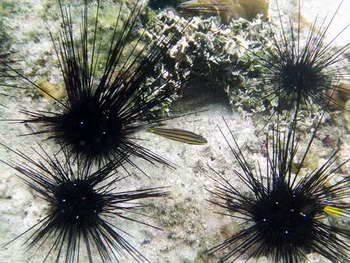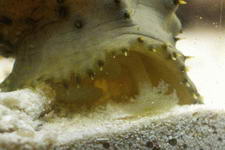Coralliths :
I see this odd coral formation from time to time within the grass bed's
sand areas as well. Formed by small coral fragments that get turned
over on a regular basis by the areas tidal movements. Usualy no more
than golf ball sized, which may be a limiting factor for this formation
as I am sure, that as they get larger, and thus heavier, the tides may
not be able to turn them over, which for the side that ends up face
down in the sand means the loss of living coral while the "lucky" side
continues to grow.

 Both sides of a
Corallith, the brightness on the right is due to sunlight
Both sides of a
Corallith, the brightness on the right is due to sunlight
These bowls also seem to act as a low tide refuge (tide
pool?)
for the black long spine urchins which graze the grass beds during
deeper water feeding not on the sea grass itself, but on the algae that
manages to grow on the odd larger rock scattered about. It is quite the
sight, to see a "herd" of a hundred sea urchins marching across the
shallows while having a great number of gold colored cardinal fish
hovering in amongst their spines.
Overall, these bowls appear to be their own
miniature
habitats and I am surprised at the number of different animals that
make these areas their homes. I can easily forget the time and spend an
entire afternoon within a single bowl marveling at what will come into
view if one only remains still long enough.


Long Spinded Urchins with
commensal Cardinal
Fish and a PipeFish hunting amongst the seagrass
Summary
: No matter where in the world that grass beds are found,
they
play a critical role in the formation of, and health of coral reefs. In
short, as goes the grass beds, so goes the reefs. A few key roles that
grass beds play include:
(A) - Sediment stabilization, Without the sea grass trapping
and
holding sediment particles, it is unlikely the coral reefs could form
in the first place, by keeping the water clear of drifting sediments,
the sea grass allows the continuation of those reefs that have formed
in near shore areas.
(B) - A habitat unto its own, the fine sediment
and
abundant nutrients creates a home for a great many microscopic plants
and animals, which forms the foundation of the sea grass nutrient web.
These in turn feed a great many other higher life forms, who become
food for yet larger animals. A lot of detrivores could not
find
suitable habitat if not for these areas as well.
(C) - A nursery area, with the shallow and
abundant cover,
The juveniles of a great many species of both crustaceans and fish can
be found living
and hiding amongst the blades of the sea grass. Few, if any, larger
predators venture into such shallow zones, thus giving the juveniles a
chance to grow up and move out to other, deeper habitats.
Application
within the Reef Keeping Hobby
- If a separate, very large, shallow aquarium could
be tied
into your aquarium's system and set up with a deep very fine "live"
sediment, heavily planted with sea grass. I feel this alone would
create a much more natural environment for all of the pets that you
keep. The production of micro life alone would add a lot of live food
that the corals and fish would benefit from. The amount of nutrient
processing that such an addition would provide would also greatly
improve the day to day water quality of the entire system. In order for
us, as hobbyists, to make the claim that we have a "reef" aquarium, I
feel we need to include all of the habitats that encompass the word
"reef", when possible.
The Human Factor
-
There is of course a downside to being able to observe a
reef,
and that is having to watch the effects that people have upon it. For a
sea grass habitat, the biggest problem is of shore run off. Within a
day of a heavy rainfall, the near shore area becomes choked in the free
floating Ulva macro and filament algae. The bacterial count
must
also go "off the scale" as I have learned the hard way that swimming
shortly after a heavy rain almost always leads to me coming down with a
sore throat and a fever. Another effect is by just the physical damage
that people do during their foraging for food. During the lowest of
tides when the grass beds are exposed, there will be at least fifty
people wandering the grass beds flipping over every rock in the entire
area in search of what ever it is that they find edible. The problem in
their doing so, is that there is a lot of life living on the "sunny "
side of the rock. Once flipped over most of that life is doomed, unless
by chance, it is again flipped over at the next low tide. Most of the
larger herbivores have also been removed. All of the sea urchins except
the black long spine species have been collected and eaten. I have seen
piles mounded up in the shallows consisting of nothing but sea urchin
skeletons. Any of the larger snail species, such as the Conch, are
snapped up just as fast as they migrate into the area. It is my hope,
that soon, I will be able to put together some educational material
that I can pass out to the people who frequent this area, and hopefully
teach them some less destructive methods, such as putting the rocks
back the way they found them and to please not step on corals that are
doing their best to eek out a living . I suppose the first step would
be to inform the locals of what a coral is. You would be surprised at
how many people here have no idea that the brown or green weird looking
rock that they stand upon is actually a living animal.
Please take
a moment and consider supporting any one of the projects listed within.
Thank you.





























